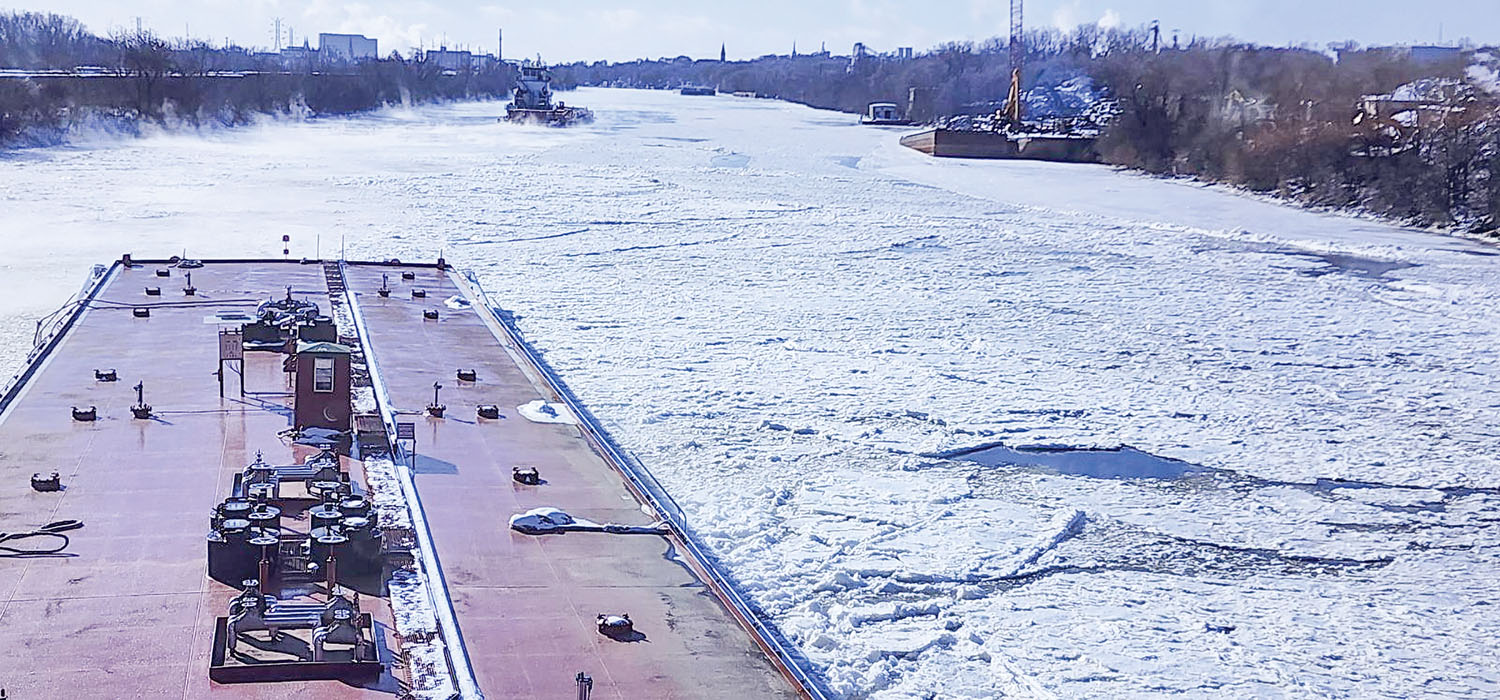Ice and fog contributed to delays on the Illinois and Upper Mississippi rivers over the past week, but warmer temperatures were already beginning to help.
Illinois River
Along the Illinois River, problems persisted in the Starved Rock, Dresden Island and Marseilles pools. As of January 23, everything from Spring Valley (Mile 218) north was virtually impassable, said Terry Bass, chairman of the Illinois River Carriers Association (IRCA).
“I’ve been almost 30 years in the towing industry, and I’ve never seen ice in some of these places,” he said. “One guy told me he hasn’t seen ice like this since the freeze of ‘77 and ‘79. It’s been historic.”
A sudden freeze that began January 11 and persisted through January 22 in northern Illinois left tows stuck in the ice in all three pools. In the past few days, some of that ice started to break loose or was expected to do so soon, and some traffic was resuming.
Ice gorging at Poor Farm Cut, Illinois River Mile 235, made conditions especially difficult in that area, Bass said.
“It was icing for us there pretty bad,” he said. “There were several boats held in that pool that were actually stuck. We had to team up to get them free and then break up the ice gorge.”
On an industry call January 24, representatives from Starved Rock Lock and Dam noted that crews managed to lock through one tow the night before, but it required locking ice three or four times to do so.
Ice was being pushed against the upper dam gates ahead of tows trying to move, and getting the gates fully reset was a “nightmare,” the caller said.
Thirteen boats were reportedly in the queue to traverse Starved Rock Lock on the afternoon of January 24, with two reporting that the ice was still too thick for them to consider moving. Typically that pool can hold six to eight boats without crowding, Bass said. Two of those tows were southbound, with the rest needing to go north, according to lock officials.
Bass said the Starved Rock lockmaster told him he had never seen ice freeze so fast.
After a relatively mild winter, ice built up 10 inches thick in five days, said Mike Blaske, general manager of Illinois Marine Towing and president of IRCA.
“It froze quickly, but I think what’s unprecedented is how thick the ice became in such a short period of time,” he said.
He added that industry had not seen icing to this extent in the past decade.
It was also difficult to prepare for, he said, with forecasts not fully grasping the expected difficulties.
“We knew that it was coming, but not to the extent that it was,” he said.
The delays at Starved Rock added to issues in the Marseilles and Dresden Island pools, Bass said. Warmer weather, with temperatures rising into the 40s beginning January 23, meant that the ice in the Brandon Road and Channahon regions was thinning out or melting entirely.
Doug Morgan, chief of locks and dams for the Rock Island Engineer District, noted that a 105-foot width restriction remained for Dresden Island, Marseilles and Starved Rock locks and that Starved Rock could see further restrictions because of the amount of ice moving downriver, even though it was beginning to melt off the lock chamber walls.
At LaGrange Lock and Dam, ice was stacking well above the waterline, 6 to 8 inches thick with 90 percent coverage, especially along the left descending bank, he said. Additionally, he said the frozen ground left nowhere for melting snow and ice to go except in the rivers and tributaries, meaning high water problems were likely for Peoria and LaGrange locks within the next few days.
“That’s going to potentially create a mess if there’s still a lot of ice in the river for them,” Morgan said.
Nathan Klein, representing Dresden Island Lock and Dam on the industry call, said that in a conversation with the Will County (Ill.) Emergency Management Agency, that the largest ice jam on record in the Kankakee River was expected to break January 25 or 26.
“So there’s going to be a ton of ice coming out of the Kankakee,” he said. “We’ll need to open three or four gates to let ice pass through to keep from damaging anything.”
Those on the call stressed the importance of any tows waiting to lock south through the dam staying above the mouth of the Kankakee River once industry had been notified that the ice was heading downriver.
Bryce Wallace with Marseilles Lock and Dam said that the canal at the lock remained completely shut down with 100 percent ice coverage.
“Hopefully this will thin out a little bit, and we’ll go back to pulling cuts in the next day or two,” he said January 24.
Blaske said the forecast showed some promise, with the next 10 days showing a warming trend in northern Illinois. Temperatures were expected to remain above freezing and could nearly reach 50, he said January 24.
“I think we’re in a good spot to get most of this ice out of the way, and then we’ll probably see it again in February,” Blaske said.
Ice was not the only obstacle for boat traffic in the northern Illinois region. The Coast Guard issued a navigation notice the morning of January 24 that a crane had collapsed and was blocking the Chicago Sanitary and Ship Canal at Mile 298.5 in Lemont. Those on the industry call that afternoon advised that the boom blocked the entire waterway and was resting on a hopper barge on the other side. The general consensus was that it would take 24 hours or more to clear the obstruction.
Upper Mississippi
Bernie Heroff, chairman of the River Industry Action Committee (RIAC), the industry group that responds to extreme conditions on the Upper Mississippi River, spoke about an ice gorge that started to form at the Interstate 57 bridge, just upriver from the confluence with the Ohio River, on the night of January 19.
Because the Ohio River was high and the Mississippi River was low, the lower miles of the Upper Mississippi had nearly no current, allowing an ice jam to start forming at the bridge thick and fast, he said.
“Instead of that ice flowing down and out of the Upper and into the Lower, it just started to accumulate between Mile 7 and Mile 10,” he said.
By the next afternoon, all traffic had stopped because of the gorge. Several light boats worked to break up the jammed ice, which broke loose the afternoon of January 22. Before the ice started moving, the stage at Cairo had fallen about 8 feet, and the stage at Price Landing, Mile 28, had increased several feet, he said. The gorged ice extended from Mile 8 to above Mile 19.
When it started moving, two vessels and their tows, a total of 35 barges, were pulled along with the ice, unable to move or stop until some of the stern barges in their tows grounded on the green buoy line at about Mile 16. Eleven vessels held their positions between Mile 28 and Mile 0 whle the fast-flowing, heavy ice left the river. No casualties were reported.
The ice flowed fast and thick until the morning of January 23. Then, when traffic was ready to start, the warm, humid air and extremely cold river created dense fog from Wickliffe, Ky., to as far north as St. Louis that came and went until lifting the afternoon of January 25. All the grounded barges were recovered by the morning of January 24.
“There are some boats that have been waiting above and below this area since Saturday,” Heroff said five days later, hours before the fog lifted.
At least some of the buoys below the I-57 bridge and Greenfield Bend were still on station, he said. Coast Guard cutters Cheyenne and Chippewa and the Corps of Engineers vessel Pathfinder expected to run the buoys beginning the week of January 29 to ensure they were positioned correctly.
Additionally, while St. Louis Harbor had 70 percent ice coverage at the peak of the freeze, it was all open water as of the morning of January 23.
With above-average temperatures expected over the next two weeks, “We won’t have any new ice forming, but we may see some short-term jams between Grafton and Mel Price Lock as the warm temps and rising stages on the Illinois River will flush the ice out of the Illinois and into the Mississippi.”
Caption for photo: Ice surrounds tows on the Illinois Waterway within the past week. (Photo courtesy of Terry Bass.)



